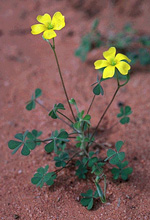 |
This is a large, worldwide family represented in Australia by the single genus Oxalis. Various native and introduced species are found from coastal dunes to subalpine woodlands and from rainforests to the deserts, almost throughout Australia (but rare in the tropical north). Most of the introduced species are weeds of disturbed areas.
Characteristic features of the family Oxalidaceae in Australia include: - perennial herbs, often with bulbs and leaves in a basal rosette, or with rhizomes and then the plants forming small, carpeting patches
- leaves often somewhat fleshy, compound, with 3 or 4 leaflets which are often obovate and bilobed or notched at the apex
- flowers yellow or pink, solitary or in umbels at the ends of the leafless scapes, with 5 sepals and petals, the latter free or shortly fused at the base
- stamens 10, often alternating long-and-short, connate into a short or long tube
- ovary superior with 5 free styles, developing into a cylindrical, often beaked, usually explosive capsule
Description
Annual, biennial or perennial terrestrial herbs. Perennating by bulbs, corms, tubers, rhizomes, stolons or taproots. Vegetative reproduction absent, or by bulbs, corms, tubers or rhizomes. Internal secretions not obvious. Plants glabrous, or with simple, glandular or non-glandular, unicellular hairs. Leaves alternate and spiral, or opposite, cauline or both basal and cauline, petiolate; pulvinae rarely present. Stipules absent, or present, distinct and free from the petiole or fused, scale-like or membranous, falling off early or persistent; stipellae absent. Lamina once compound or bicompound, ternate or rarely unifoliolate, palmate, paripinnate or imparipinnate, symmetric; lobes/leaflets filiform, acicular, subulate, linear, elliptic, oblanceolate, obovate or flabellate; base cuneate or attenuate; margins entire, ±flat; venation pinnate, or palmate, with the midrib conspicuous, and the tertiary venation reticulate or not; surfaces punctate or not punctate; herbaceous. All the flowers bisexual. Inflorescences terminal or axillary, consisting of racemes, cymes, umbels or solitary flowers. Bracts present. Bracteoles present or absent. Pollination by insects. Flowers stalked. Floral disc absent; nectaries present on the stamens. Perianth of 2 dissimilar whorls,or rarely of 1 whorl only, imbricate in bud. Calyx regular; segments free, with 5 sepals, herbaceous. Corolla rarely absent, regular; segments free or fused, with (0–) 5 petals or lobes, alternating with the sepals, wheel-shaped, white, yellow, pink, magenta or purple, without contrasting markings, membranous; claws present or absent; lobes ±entire. Fertile stamens 10, both opposite to and alternating with the sepals, free of the corolla, free of the ovary and style, distinct from each other or fused by their filaments into an open or closed tube, all ±equal or distinctly alternating long and short. Staminodes present or absent. Anthers dorsifixed, versatile, opening inwards by longitudinal slits, 2-celled; appendages absent or basal. Ovary superior and sessile. Carpels (3–) 5, fused; ovary with (3–) 5 locules. Style terminal, branching from the base. Ovules 1–numerous per locule, usually stalked; placentation axile. Fruit a dry or fleshy loculicidal capsule with elastically explosive dehiscence; the perianth on the maturing fruit deciduous, or dry and persistent. Disseminule micro-surface ±smooth, tuberculate or reticulate, cream or brown, glossy or dull. Seeds 5–numerous per fruit. Aril present or absent. Cotyledons 2. Embryo straight.
(Note: this description has been generated from the coded data compiled for the key. Any errors in the key data will be reflected in the descriptions.)
A treatment of the family Oxalidaceae has not yet been published in the Flora of Australia. It will appear in Volume 27.
Australian genera of Oxalidaceae (as recognised for the Flora of Australia)
† = some species native, others introduced
Biophytum
†Oxalis

|
  |

Oxalis perennans (flowers)
Photo: D.Hardin © D.Hardin

Oxalis sp. (flowering plant)
Photo: M.Fagg © ANBG
|

| |